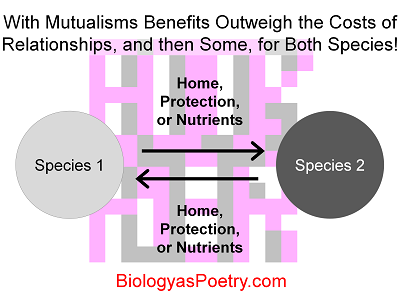∞ generated and posted on 2016.08.29 ∞
Interspecific interaction in which both species benefit.
This contrasts with parasitism, where one individual gains but at the expense of the other, and commensalisms where one individual's gains have no impact, either positive or negative, on the other. It is important to realize that a mutualism does not mean that the parties involved are in no way negatively impacting each other. Instead, mutualism means that the net impacts each individual has on the other will make up for any negative impact that might also occur.

Figure legend: In symbiotic relationships one species supplies to the other various benefits including a place to live (home), protection from biotic or abiotic components of the environment, and/or various beneficial chemicals (nutrients). In a mutualism these benefits are provided also in the other direction, though the benefits need not be identical going from Species 1 to Species 2 nor need the magnitude of the benefits going in either direction be the same. Indeed, there can even be costs to mutualistic relationships, though for the relationship to be mutualistic then the benefits, for both species, must outweigh the costs, also for both species.
Make sure that you are aware that the word inter-specific is being employed, that is, interactions between species, rather than those that are intra-specific, which refers to interactions among members of the same species. Mutualisms often are co-evolved interactions meaning that each species has adapted to the relationship in such a way that the mutual benefit is more stable and secure.
Mutualisms are more likely to develop under circumstances where the fates or at least the attainment of benefits by interacting organisms are linked, that is, such that any harm or simply an absence of helping of the other organism in some manner costs the harming or at least not helping individual. This is most obviously observed when the reproduction of one organism is dependent on the other organism and vice versa. Examples of the linkage of reproductive fates, though intraspecific, can be found in the co-parenting of offspring as seen with humans as well as birds, where insufficient participation can negatively impact not only the other parent's reproductive success but one's own reproductive success as well. Fates, however, can be even more linked such as the vertical transmission of mutualistic symbiotic organisms to the offspring of their hosts.